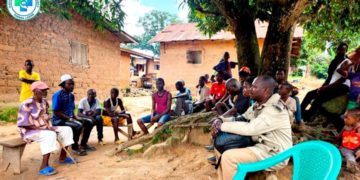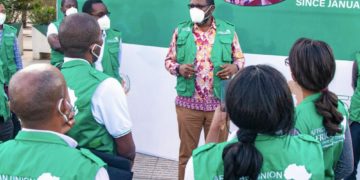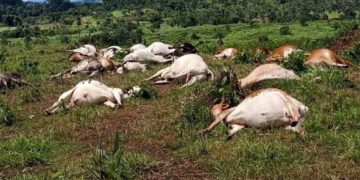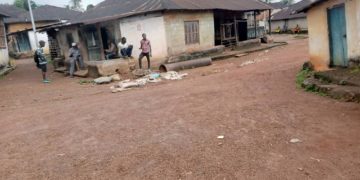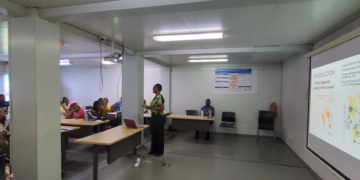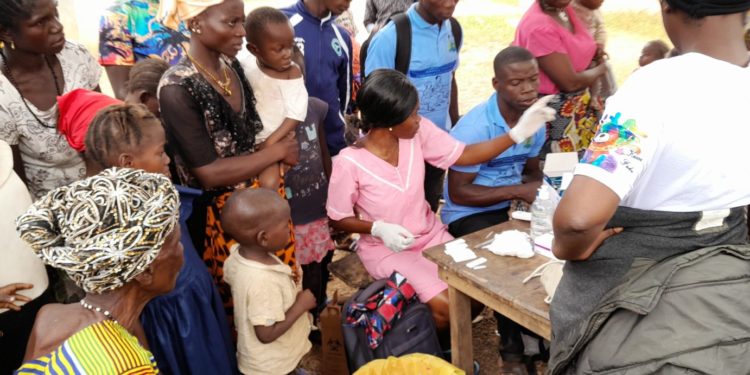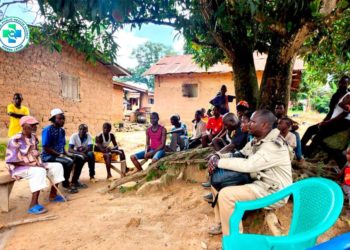By Kemo Cham
First published on the print edition of Politico Newspapers
In Gbom Samba, out of 97 people tested for malaria in just one day, 96 of them were found to be positive for the parasitic disease.
The villagers were tested as part of the Static Campaign – an initiative by a consortium of local and international organizations – which is geared towards accelerating the response to Malaria, one of the highest killer disease among children and women, Tuberculosis and HIV/AIDS.
Community volunteer, Ibrahim Bangura helped mobilize the people of Gbom Samba for the testing in early December. He recalls the health workers running out of test kits during the exercise.
Otherwise, Bangura notes, the number of positive cases would have far exceeded that.
In the communities they already covered, out of every 10 people tested, between 7 and 8 were found to be positive, he said.
“That gives you an indication of how serious the situation is in this district for malaria,” Bangura, who coordinates the activities of FOCUS 1000 in Karena District, says.
Gbom Samba, a mainly agrarian community in north-western Sierra Leone, is a microcosm of the larger district in terms of the prevalence of malaria.
Sierra Leone is considered a malaria endemic nation, which means that the parasite that causes the disease is constantly present in the population. It has a malaria prevalence rate of 22%, according to the 2021 Malaria Indicator Survey (MIS). This actually represents a drop from 43% since the previous survey in 2016.
But according to the World Health Organization (WHO), the entire Sierra Leonean population is 100 percent prone to the disease.
The reality in Gbom Samba and the larger district in many ways illustrates the challenges the country faces in its efforts to control and eventually eliminate malaria, in line with the UN Sustainable Development Goals (SDGs).
According to the Health Ministry, over two million people visit hospitals annually with malaria, with over 6, 000 of the cases resulting to deaths. Children under five and pregnant women are mostly affected.
The World Malaria Report (WMR) 2023 shows that the WHO African Region continues to shoulder the heaviest burden of the disease, accounting for 94% of the 233 million cases recorded in 2022, and 95% of all 580, 000 deaths recorded within the same period.
About 78% of all malaria deaths in the region were among children under the age of five, according to the report.
Although the overall data over the long term, from 2000 to 2022, show that malaria case incidence and mortality rates in the region declined, the situation in most recent times show a worrying trend.
In 2022, for instance, the global tally of malaria cases reached 249 million – well above the estimated number of cases before the COVID-19 pandemic, and an increase of five million over 2021, according to the WMR.
Inadequate infrastructure
Malaria poses a “significant health burden” on countries like Sierra Leone with high transmission rates year-round. It strains healthcare resources, hinders economic productivity, and challenges access to care, as indicated by the situation in Karene.
Karene stands out in that, as a new district, it’s constrained by inadequate infrastructure to handle a lot of development issues, including poor road network and many hard-to-reach communities.
“This makes it difficult for people to access health facilities,” says Bangura, noting that added to inadequacies at the health centers, many people are forced to rely on quack doctors as alternative for healthcare services.
The Static Campaign, supported by the Global Fund, is designed to help Sierra Leone overcome such limitations. The initiative being implemented in all 16 districts of the country, entails outreach activities like the one held in Gbom Samba, where residents are tested and treated if they are found to have the disease.
A key aspect of the campaign is awareness raising on the preventive measures against the targeted diseases.
The focus of the anti-malaria response of the Sierra Leone government and its partners is prevention, through regular spraying of homes in communities that are highly prone to mosquito bites, the use of Insecticide Treated Bed Nets (ITNs) and environmental sanitation.
The Health Ministry is presently working on its next round of distribution of ITNs slated for next year.
Mid December, the government took stock of the first batch of the landmark WHO approved malaria vaccine, RTS,S.
But a major concern for the government and its partners is getting the people stick to the recommended preventive measures, like the proper use of the ITNs. In many communities across the country, people use the nets for fishing, while others use them to fence their gardens.
These are some of the issues the Static Campaign has been working on addressing through sensitization. And data from the Health Ministry show that the efforts are paying off, although challenges remain.
The Static initiative is headed by the Catholic Relief Services, which is working with several other organizations like FOCUS 1000, CARITAS Kenema and Pikin to Pikin, as well as the District Health Management Teams (DHMTs).
“Going to communities we found out that there is a lot of gaps in terms of the importance of the use of the bed nets,” says Mohamed Rashid Kargbo, Malaria Focal Person at the Bombali DHMT.
Kargbo represents the DHMT in the activities of the campaign.
Mohamed Bailor Jalloh, Chief Executive of FOCUS 1000, says for malaria to be put under control, it needs to be confronted from all fronts – proper use of the bed nets, sustained environmental sanitation and the use of the vaccine, which he describes as the “icing on the cake” in the fight against the disease.
“One strategy cannot do it,” he says, stressing that education is key.
“The malaria vaccine is here to help boost the fight, and if we all do it together – government, NGOs, communities and parents – I can assure you that we will be able to control malaria,” he says.
FOCUS 1000 relies on its grassroots community engagement partner – the Kombra Network – to help in the crucial efforts of community engagement and passing of lifesaving messages with the goal of effecting behavioral change.
“Malaria is a very difficult disease to deal with. We have for a long time been talking about eradicating it, but that’s not possible, but we can control it,” says Jalloh, adding: “One of the ways we can deal with it is to test and treat people… The second way is to attack the mosquito itself. That is why we focus on environmental sanitation,” he said.
Stories on the ground in far-flung communities like Gbom Samba emphasise on the need for sensitization.
In Dogolia, a few miles outside Kabala, the headquarters of neighbouring Koinadugu, another malaria endemic district, Community Health Nurse Fanta Haja Fofana is enjoying a break from the usually busy schedule attending to patients.
She recalls how during the peak period in the rainy season the Gogolia Community Health Post is almost always inundated with patients, many of whom end up diagnosed with malaria.
A mother herself, Fanta says behaviour change is the key to controlling the parasitic disease, and she feels this is very much needed in the area of environmental sanitation and attitude toward the use of bed nets.
“Mosquitoes breed in dirty places. You don’t see them in clean places. So if we take care of our environment, we will reduce malaria,” she says.
The weather phenomenon is considered as one of many threats to the global response to malaria.
The WHO World malaria report provides a comprehensive and up-to-date assessment of trends in malaria control and elimination across the globe. The latest report points out that millions of people continue to miss out on the services they need to prevent, detect, and treat the disease, citing conflicts and humanitarian crises, resource constraints and biological challenges such as drug and insecticide resistance as continuing to hamper progress.
This year’s report, published at the end of November, also includes, for the first time, a dedicated chapter focused on the intersection between climate change and malaria.
“Taken together, these threats are undermining gains in the global fight against malaria,” says the report.

